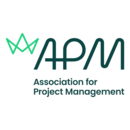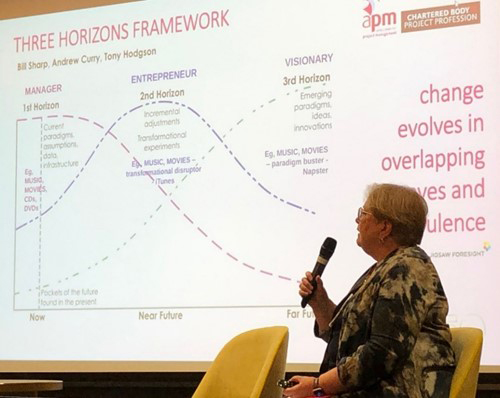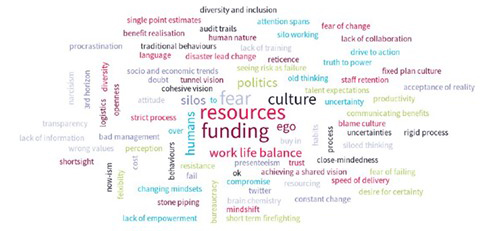Driving projects APM multi SIG conference 2022
[edit] Driving projects "looking through the windscreen"
Exploring the opportunities, challenges and techniques - APM multi SIG conference 2022
Tuesday 18 October 2022 at the Crowne Plaza Kings Cross saw the first ever multi-SIG conference. It had taken over eight months to plan, structure and organise - coordinating the multiple SIGs was a challenge. On the day we had nearly 100 attending and received lots of positive feedback such as “I found it a valuable learning experience myself as well as a great networking opportunity” and “Really enjoyed the event and speaking to so many likeminded people with a real passion and drive to improve project delivery”.
[edit] Welcome note
Andrew Wright and Pamela Stacey (Co Chairs) introduced the conference, welcomed everyone and outlined the day.
The aim of the conference was to look at refocusing how we plan and execute projects, and we challenged the participants by asking – 'If we went on a journey the way we plan and execute projects would we get to our destination, and would we get there on time?'. The focus of the day was on driving projects like cars - looking ahead, ‘through the windscreen’.
[edit] Participants
Six SIGs participated:
- Assurance
- Contracts and Procurement
- Governance
- Portfolio Management
- Risk
- Systems Thinking
Following the introduction Andrew and Pamela handed over to Chris Blockley-Webb as ‘Master of Ceremonies’ for the first session
[edit] 1st session – What happens if we don’t focus on the future?
Chris led the Q&A session, putting a series of questions to the panel based on our journey analogy – see below. The questions generated a range of perspectives and considerations across the different industries and stimulated the audience to think differently, focusing on the future and delivering the target benefits. The examples related by the panel helped illustrate the damage of unforeseen impacts and to contrast different planning horizons; timelines may be up to several generations in the nuclear industry.
Preparing for the Journey:
- Why is it so important now to refocus on looking forward?
The Journey:
- Why is it so important keep focus on looking forward?
- Do projects ever use foresight to deliver success?
The Destination:
- How will we know we are taking the right journey and it’s the right destination?
Key points included considering the emotional effect on the stakeholders, often overlooked, which can generate problems later in the project. Environmental and sustainability considerations are also becoming increasingly important and starting to impact our plans and project delivery.
There also needs to be a culture shift in organisations to focus on the future, and some countries have already made that shift. Japan, for example, looks at a 7th generation view in to the future; the philosophy that today’s decisions should stand for the next seven generations.
The sailing-boat analogy of managing projects was seen as useful by the group – while everything is carefully balanced it is controllable and moving in the right direction, but an unforeseen change or unpredicted event can impact progress and capsize the whole boat unless the right reactions happen immediately.
Our illustrious panel included representatives from a range of organisations. Left to right in the photo:
- Andy Murray, Major Projects Association and Governance SIG Chair;
- Andrew Wright, Transformation and Change Consultant, and Systems Thinking SIG Chair;
- Dr Wendy Schultz, Futurist at Jigsaw Foresight;
- Jo Stanford, Head of Futures & Profession, Health Education England;
- Tony Gibson, Chief Delivery Engineer, Sellafield.
[edit] 2nd session – ‘How can we increase the focus on the future?’
Following a break for coffee, the next session was a set of parallel structured workshops, each led jointly by two SIGs.
- Group 1 – Governance and Risk
- Group 2 – Assurance and Portfolio Management
- Group 3 – Contracts & Procurement and Systems Thinking
The short presentations outlined the role of each discipline in the group and how they overlap and are interdependent. This led to a stimulating discussion with a variety of points of view and debating real-life situations with the participants, the group suggesting ways to develop and overcome barriers etc.
Whilst each presentation and discussion focused on different project-related topics, some key themes emerged that were common across each group:
Behaviours were seen as key to focusing on the future. If the right behaviours are role-modelled, encouraged and rewarded this will drive the right culture. Fostering and valuing emotional intelligence provides a supportive work environment.
It was emphasised that empowerment increases agility and moves projects away from hierarchical decision-making processes that could hinder progress.
Working collaboratively and breaking down the silos generates trust, a key contributor to successful delivery.
The importance of critical thinking and the use of critical thinking tools was raised in all groups – stepping back and looking at the bigger picture rather than focusing on imminent milestones and project plans that may be out-of-date.
The need for partnerships and shared values were seen as important. Better use of the "Critical Friend” approach where challenge was seen as positive and promoted project improvements in a positive working environment.
Other important topics, such as the need to increase uptake of technology, to be bold, and to embrace uncertainty were also discussed.
[edit] 3rd session – What are the opportunities and challenges of looking forward?
Wendy Schultz and Jim Scopes from Jigsaw Foresight explained their role, their approach and ways of working to advise on the future –there are always multiple futures that might develop and it is based primarily on possibilities, not predictions. Their approach is to highlight the three horizons: now and the immediate future, the near future, and the far future. Analysing and predicting using these three horizons helps to explain what changes might happen and how organisations might adapt, or may even be able to influence the future.
Wendy and Jim also reported their perspective on the discussions during session 2’s parallel sessions, both reinforcing the points already reported by Pamela, and adding their own opportunities.
Our audience was fascinated by the presentation and the horizon timelines, which will be dependent on the industry. Oil and nuclear for example have extended horizons with the implications of what we do now affecting people for hundreds of years or more.
Riding on the inspiration created by Wendy and Jim, we then posed two questions to the attendees. In each case, there was vigorous discussion around each table summarised and reported using Mentimeter:
- What are the opportunities we are missing out on?
- What are the key challenges we need to overcome to realise these opportunities?
Initially we identified the opportunities for change and what organisations typically miss out on.
Key opportunities highlighted were boosting collaboration across the teams within the organisation, planning in resilience to change and thorough planning for alternative scenarios. If these were better addressed by our stakeholders it would help improve the performance of the organisation, potentially reducing risk and helping to focus more on the future.
The second Mentimeter asked the question ‘what are the key challenges we need to overcome’ to increase our capability to ‘look forward’.
Resources and funding – the lack of them – was the key concern, but closely followed by culture. Many organisations need to change their ways of thinking and behaviours, i.e. culture, to be more forward looking. This was a seen as major limitation. Stakeholders’ individual egos and their ‘pet projects’ or inflexible thinking also often inhibited forward thinking and responsiveness, and priorities were often short term.
[edit] 4th session – Who do we need to convince of the need to be forward-looking? How can we help key stakeholders to change (and be more responsive)?
The aim of the session was to debate who we need to convince of the need to be forward looking and how we help our key stakeholders to change. Again we used Mentimeter to collate the answers.
We need to convince, and how can we help convince:
Ourselves
- Stay aware - notice “weak signals” of things going awry
- Say no to endless wasteful meetings and block out thinking time
- Relating to others’ points of view
- Confident uptake of technology
- Collaborate effectively and willingly
- Reveal their fears and hopes associated with looking forward
- Recognise their vested interests
- Discriminate between their genuine needs and their wants
- Improve and increase communication and conversation
- Engagement of all stakeholders
- Shared vision of purpose
- Incremental improvement is good, as transformational change is often resisted
- Make it safe to look forward, enable people to flag up forward-looking concerns, then reward and recognise them for looking forward
- Encourage skill/disciplines (thinking) not just processes (doing)
- Empowerment of individuals
- Develop transparency and honesty
- Trust between collaborators
- Work to shared values
[edit] Final session - Wrap up and close
The key conclusions drawn were that building trust and transparency were essential to becoming more forward-looking in delivering projects, so delivering greater success. The potential threat of telling truth to power was seen as a major inhibitor. Andy shared the link to a recent Systems Thinking SIG webinar addressing how to do that.
Andy and Pamela brought the conference to a close by thanking all the speakers and participants and, given the success of this multi SIG event, look to next year and working with and across the SIGs to highlight the overlaps, interdependencies and joint benefits. ‘Real life’ projects involve all the disciplines to help them ‘look through the windscreen’.
Appendix - SIG leads at the conference
- Assurance SIG: Pamela Stacey (conference Co Chair)
- Contracts and Procurement SIG: Ian Heptinstall
- Governance SIG: Andy Murray
- Portfolio Management SIG: Steve Leary
- Risk SIG: Chris Blockley-Webb
- Systems Thinking SIG: Andy Wright (conference Co Chair)
The presentations have been shared with the conference attendees.
This article appears on the APM news and blog site as "Driving projects "looking through the windscreen": multi SIG conference 2022" on November 15, 2022.
--Association for Project Management
[edit] Related articles on Designing Buildings
- APM articles.
- Client design advisor.
- Code of practice for project management.
- Code of practice for programme management.
- Commercial management.
- Commercial manager.
- Construction project manager - morning tasks.
- David Trench - A career in projects.
- Design management.
- Dynamic conditions for project success.
- Independent client advisor.
- Interview with Paloma Hermoso, Senior Project Manager CIOB MAPM, Baker Ruff Hannon.
- Interview with Stephen Trench - Project manager.
- Lead consultant.
- Lead designer.
- Project manager.
- Project manager's report.
- Project sponsor.
Featured articles and news
Amendment to the GB Energy Bill welcomed by ECA
Move prevents nationally-owned energy company from investing in solar panels produced by modern slavery.
Gregor Harvie argues that AI is state-sanctioned theft of IP.
Heat pumps, vehicle chargers and heating appliances must be sold with smart functionality.
Experimental AI housing target help for councils
Experimental AI could help councils meet housing targets by digitising records.
New-style degrees set for reformed ARB accreditation
Following the ARB Tomorrow's Architects competency outcomes for Architects.
BSRIA Occupant Wellbeing survey BOW
Occupant satisfaction and wellbeing tool inc. physical environment, indoor facilities, functionality and accessibility.
Preserving, waterproofing and decorating buildings.
Many resources for visitors aswell as new features for members.
Using technology to empower communities
The Community data platform; capturing the DNA of a place and fostering participation, for better design.
Heat pump and wind turbine sound calculations for PDRs
MCS publish updated sound calculation standards for permitted development installations.
Homes England creates largest housing-led site in the North
Successful, 34 hectare land acquisition with the residential allocation now completed.
Scottish apprenticeship training proposals
General support although better accountability and transparency is sought.
The history of building regulations
A story of belated action in response to crisis.
Moisture, fire safety and emerging trends in living walls
How wet is your wall?
Current policy explained and newly published consultation by the UK and Welsh Governments.
British architecture 1919–39. Book review.
Conservation of listed prefabs in Moseley.
Energy industry calls for urgent reform.































